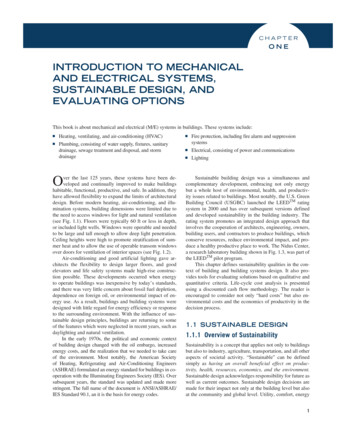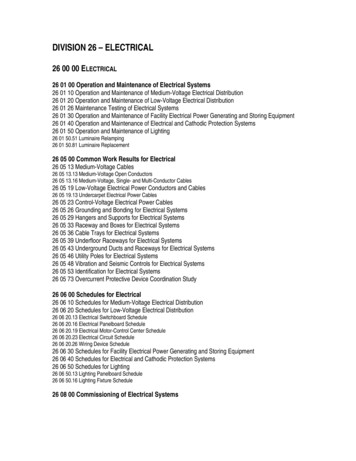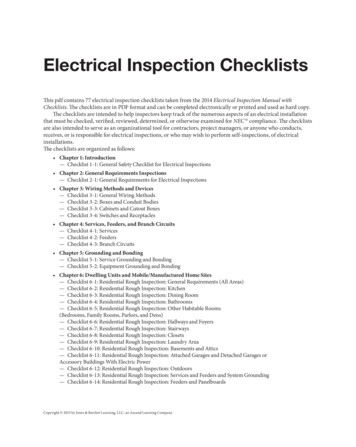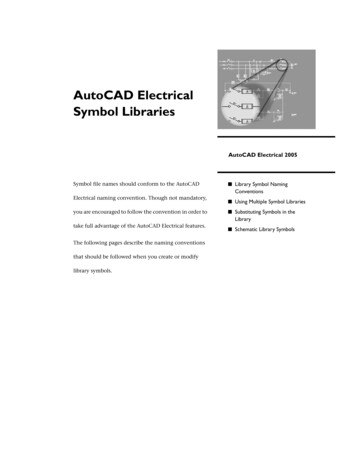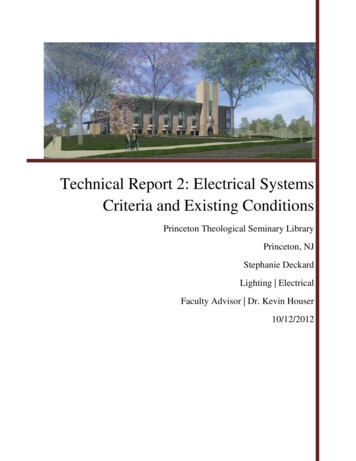
Transcription
Technical Report 2: Electrical SystemsCriteria and Existing ConditionsPrinceton Theological Seminary LibraryPrinceton, NJStephanie DeckardLighting ElectricalFaculty Advisor Dr. Kevin Houser10/12/2012
Princeton Theological Seminary Library Senior Thesis Technical Report 2 Stephanie DeckardExecutive SummaryThis report identifies the electrical design criteria based on the building type, details the actualelectrical design, evaluates the existing performance of the building based on this information and makessuggestions on how to improve the performance of the building. Numerical data being calculatedincludes normal, emergency power and optional back-up power loads. Other evaluation criterion includesequipment choices, voltage, services and rate schedule choices, building services andspecial/communication systems.Based on the design criteria and priority assessment, the existing electrical distribution design fitsthe functions of the building really well. There are some improvement suggestions that could beimplemented to save energy and/or increase control over the building systems and safety. Increasingintegration by connecting the fire alarms with the telephone, intercom or CATV through data connectionswould increase the occupant awareness in case of an emergency, vastly increasing safety. Costs savingsolutions include both energy saving techniques as well as suggestions on equipment changes. Todecrease the energy usage of the building, demand reduction and demand shifting could be implemented.Combining equipment such as the smaller transformers providing service to the electrical rooms on eachfloor as well as combining the electrical rooms on each floor into one room versus many small roomswould allow for that floor area to be used for a different purpose.2 Page
Princeton Theological Seminary Library Senior Thesis Technical Report 2 Stephanie DeckardTable of ContentsExecutive Summary . 2Part 1 Electrical System Criteria and Scope of Work . 4I.II.III.IV.V.VI.VII.VIII.IX.X.XI.Preliminary Electrical Load Calculation . 4Power Company and Preliminary Rate Schedule . 4Preliminary Building Utilization Voltage . 5Emergency Power Requirements . 5Special Occupancy Requirements. 7Special Equipment . 7Priority Assessment . 7Optional Back-up Power . 8Special/Communications Systems . 9Other Building Services . 9Major Equipment . 10Part 2 Electrical System as Currently Designed. l Connected Building Load. 11Power Company and Rate Schedule . 12Building Utilization Voltage . 13Emergency Power System Loads. 14Special Occupancy Requirements. 14Special Equipment . 15General Equipment . 15Optional Back-up Loads . 16Special/Communications Systems . 17Other Building Services . 17Electrical and Communications Systems Spaces . 18Energy Cost Savings and Energy Reduction Techniques . 18Single Line Diagram . 19Part 3 Evaluation of Criteria vs. Current Design . 20I.II.III.IV.V.VI.VII.VIII.IX.Building Loads. 20Power Company Rate Schedule . 20Building Utilization Voltage . 21Emergency Power System . 21General Equipment . 21Optional Back-up Power and UPS Systems . 22Cost Reduction Techniques . 22Systems Integration. 22Energy Cost Savings and Energy Reduction Techniques . 233 Page
Princeton Theological Seminary Library Senior Thesis Technical Report 2 Stephanie DeckardPart 1 Electrical System Criteria and Scope of WorkThe following section describes in detail the design criteria for this type of building andidentifies potential building systems and electrical requirements.I.Preliminary Electrical Load CalculationInformation taken from www.eia.gov was used to calculate the average electrical load of thebuilding. Libraries are included in the category of office building which has a site electricity average of198 billion kWh or 18.9 kWh/sqft. This value is broken down into the following categories:Lighting 8.32 kWh/sqftOffice Equipment 4.54 kWh/sqftVentilation 1.51 kWh/sqftCooling 2.65 kWh/sqftSpace Heating 0.57 kWh/sqftOther 1.51 kWh/sqftThese correspond to approximately:Lighting 2.5 W/sqftReceptacle and other 1 W/sqftMechanical 4.1 W/sqftSpecial Equipment 6 W/sqftII.Power Company and Preliminary Rate SchedulePSE&G (Public Service Enterprise Group) is the power company that supplies power to thePrinceton, NJ area. PSE&G serves almost three quarters of New Jersey’s population and provides bothelectric and gas service. The Princeton Theological Seminary Library falls under the rate schedulecategory General Lighting and Power Service (GLP). The primary service voltage chosen is 2,400/4,160(4kV) volts, three phase, four wire, WYE. This information was taken from the following /electric/pdf/electric tariff.pdf4 Page
Princeton Theological Seminary Library Senior Thesis Technical Report 2 Stephanie DeckardIII.Preliminary Building Utilization VoltageThe Building Utilization voltage will be 480/277V with the voltages shown below serving each ofthe following loads:Lighting 277VReceptacle 120VMechanical 480V 3P with small step down transformers where neededSpecial EquipmentElevators @ 480VAudio Signal Processing, Amplification, and Reproduction Equipment @ 120VInformation Technology Equipment @ 120VSolar Photovoltaic (PV) systems @ 120VIV.Emergency Power RequirementsConsidered as occupancy type Assembly A-3, the following are emergency power requirementsbased on the International Building Code. The estimated loads for the emergency power use an averageof 1 footcandle in areas that require lighting during a power failure for safety and egress purposes. Allother requirements mentioned in relation to this building are listed below. Emergency power will beprovided through a diesel generator at 480/277V. A preliminary load calculation based on the criteriabelow can be broken down into the following categories:Lighting 0.12 W/sqftExit signs, egressMechanical 0.7 W/sqftSmoke control, horizontal sliding doorsSpecial Equipment 2 W/sqftElevators, intercom, platform liftsTotal 2.82 W/sqft5 Page
Princeton Theological Seminary Library Senior Thesis Technical Report 2 Stephanie DeckardEmergency power shall be provided for voice communication systems with an approved emergencypower source. (907.2.1.2)Standby power shall be provided for smoke control systems with two sources of power. Primary power isfed from the normal building power and secondary power from an approved standby source. (909.11)Emergency power shall be provided for exist signs from storage batteries, unit equipment or an on-sitegenerator. (1011.5.3)Emergency power shall be provided for means of egress illumination in the following areas (1006.3):Aisles and unenclosed egress stairways in rooms and spaces that require two or more means ofegressCorridors, exit enclosures and exit passagewaysExterior egress components at other than the level of exit discharge until exit discharge isaccomplishedInterior exit discharge elementsExterior landings for exit discharge doorwaysStandby power shall be provided for elevators that are part of an accessible means of egress and shall bein accordance with the following (1007.4):Standby power shall be manually transferable to all elevators in each bankWhere two or more elevators are controlled by a common operating system, all elevators shallautomatically transfer to standby power within 60 seconds after failure of normal power wherethe standby power source is of sufficient capacity to operate all elevators at the same time.Where the standby power source is not of sufficient capacity to operate all elevators at the sametime, all elevators shall transfer to standby power in sequence, return to the designated landingand disconnect from the standby power source. After all elevators have been returned to thedesignated level, at least one elevator shall remain operable from the standby power source.The elevator machine room ventilation or air conditioning shall be connected to the standbypower sourceStandby power shall be provided for platform lifts that are part of an accessible means of egress (1007.5)Standby power shall be provided for horizontal sliding doors (1008.1.3.3)The doors shall be power operated and shall be capable of being operated manually in the eventof a power failureThe door assembly shall have an integrated standby power supplyThe door assembly power supply shall be electrically supervised6 Page
Princeton Theological Seminary Library Senior Thesis Technical Report 2 Stephanie DeckardV.Special Occupancy RequirementsAs listed in Chapter 5 of the National Electric Code Book 2011, the following special occupancyrequirements apply to the Princeton Theological Seminary Library.Section 518 Assembly OccupanciesVI.Special EquipmentAs listed in Chapter 6 of the National Electric Code Book 2011, the following special equipmentcould potentially be included in the Princeton Theological Seminary Library.Section620 ElevatorsSection640 Audio Signal Processing, Amplification, and Reproduction EquipmentSection645 Information Technology EquipmentSection690 Solar Photovoltaic (PV) systemsVII. Priority AssessmentA priority assessment was conducted to determine which of the following characteristics are ofhigh, medium or low importance. This ranking was based on the building type and uses as well theassumed loads and long term building owner.HighLong term ownership cost is very important because the Princeton Theological Seminary Schoolwill own and occupy the building. This library will most likely be used for a long time based on theinformation known about the library building that used to occupy this plot. The Speer Building that waserected in 1957 was only recently demolished in 2010 to build this addition.Power quality is also very important because the building contains data and server rooms thatwould be heavily affected by unwanted harmonics.7 Page
Princeton Theological Seminary Library Senior Thesis Technical Report 2 Stephanie DeckardMediumInitial cost is of medium importance because any energy saving techniques would benefit theowner in the long run but being a school, they do not have an endless amount of money to spend.Each space in the building has a very specific purpose so flexibility is not a large concern. It stillmuch be considered though because as technology improves, new computers will be installed as well asnew video conferencing equipment in the Assembly Room.Reliability is important in this building because of the large number of computers being used.LowRedundancy is a low priority because it could not be utilized in the majority of the spaces due tothe fact that there are many different types and sizes of spaces throughout the building.VIII. Optional Back-up PowerThe following loads should be on back-up power by either a generator, for long term power thatwill have an initial power outage or a UPS for short term power with no blackout time.GeneratorLighting in Mechanical and Electrical RoomsHVAC in Mechanical and Electrical RoomsTotal 1 W/sqftUPSServer RoomComputer RoomsTotal 2 W/sqft8 Page
Princeton Theological Seminary Library Senior Thesis Technical Report 2 Stephanie DeckardIX.Special/Communications SystemsThe following special and communications systems are a preliminary selection of what could beimplemented into the Princeton Theological Seminary Library. Additional information is provided fromthe International Building Code on information regarding the implementation of fire alarms.Telephone/dataCATVFire alarmA manual fire alarm system shall be installed in Group A occupancies having anoccupant load of 300 or more. Manual fire alarm boxes are not required where thebuilding is equipped throughout with an automatic sprinkler system and the alarmnotification appliances will activate upon sprinkler water flow. (907.2.1)Emergency voice/alarm communications systems shall be provided with an approvedemergency power source. (907.2.1.2)IntercomAccess Control – card access after hoursSecurity – video surveillanceX.Other Building ServicesThe following building services are a preliminary selection of what could be implemented intothe Princeton Theological Seminary Library.TelephoneDataCATV9 Page
Princeton Theological Seminary Library Senior Thesis Technical Report 2 Stephanie DeckardXI.Major EquipmentTypical major equipment used in this type of occupancy includes electrical equipment, large datacenter equipment and mechanical equipment. More specifically, rooms dedicated to transformers,switchgear, distribution panels as well as cooling towers and any major data equipment.10 P a g e
Princeton Theological Seminary Library Senior Thesis Technical Report 2 Stephanie DeckardPart 2 Electrical System as Currently DesignedThis section provides information on the actual building loads, equipment and building systems.I.Actual Connected Building LoadThe actual connected building load is broken down into categories of lighting, receptacle,mechanical, special equipment and the total load as listed below.11 P a g e
Princeton Theological Seminary Library Senior Thesis Technical Report 2 Stephanie DeckardII.Power Company and Rate SchedulePSE&G is the power company for the Princeton Theological Seminary Library. The primaryservice voltage chosen is 13,200/7,620V, 3P, 4W. Information about the rate schedule was requestedfrom the building owner.12 P a g e
Princeton Theological Seminary Library Senior Thesis Technical Report 2 Stephanie DeckardIII.Building Utilization VoltageThe electrical service provided to the building at 13,200/7,620V is fed into the main serviceswitchgear, owned by the building owner, that branches out to two transformers. Transformer XFMR TSG-L-3 steps down the voltage to 4,160/2,400V and serves the existing substations that provide power tothe Luce Building. Transformer XFMR T-SG-L-2 steps down the voltage to 480/277V and servesSwitchboard SG-L-2. This switchboard branches off to individual loads, distribution panels,switchboards and power panels that supply service to both existing and new loads.Lighting 120V and 277VReceptacle 120VMechanical:AHUs @ 480VVAVs @ 277VChillers @ 480VUnit Heaters @ 120VExhaust Fans @ 480V and 120VFan Coil Units @ 480V and 120VFreezer Protection Pumps @ 480VGlycol Fill Tank @ 120VChilled Water and Heat Pumps @ 480VReturn Fan @ 480VDuplex Septic Pump @ 208VTransfer Fans @ 120VSpecial EquipmentElevators @ 480VAudio Signal Processing, Amplification, and Reproduction Equipment @ 120VInformation Technology Equipment @ 120VSolar Photovoltaic (PV) systems @ 120V13 P a g e
Princeton Theological Seminary Library Senior Thesis Technical Report 2 Stephanie DeckardIV.Emergency Power System LoadsThe emergency power is supplied by a generator at 400KW/500KVA, 3P, 4W, 60HZ, 480/277V.The generator is an outdoor, diesel driven unit in a sound attenuated nonwalk-in enclosure. Power fromthis generator is supplied to a distribution panel that has branches for the existing fire pumps anddistribution panel in the Luce Building, an emergency distribution panel, an optional backup distributionpanel and Panel EAP-IT that provides back-up power to the server room in the Luce Building.V.Special Occupancy RequirementsThere were no special occupancy requirements in the building drawings or specifications.14 P a g e
Princeton Theological Seminary Library Senior Thesis Technical Report 2 Stephanie DeckardVI.Special EquipmentInformation on the special equipment was found on the building drawings in the floor plans andappliance schedules.Section 620 ElevatorsSection 640 Audio Signal Processing, Amplification, and Reproduction EquipmentIntercom, CamerasSection 645 Information Technology EquipmentEquipment Racks in the Server Room, ComputersSection 690 Solar Photovoltaic (PV) systemsVII. General EquipmentThe general equipment located in the drawings and specifications is documented here in detail, toget an idea of the systems used in the design of the Princeton Theological Seminary Library. The mainservice transformer, rated at 15KV, 600A, is located in the basement of the new addition and is owned byPSE&G. The main service from this transformer is provided through a 600A, 13,700/7,620V, 3P, 4W,single ended, indoor switchgear. There are two transformers that branch from the main serviceswitchgear. T-SG-L-3 is rated at 20,000KVA, 3P, 60HZ, 4,160/2,400V and XFMR T-SG-L-2 is rated at1,500/1,725KVA, 3P, 60HZ, 480/277V. Both are dry-type, ventilated, NEMA 250, type 2 transformers.The panelboards for the building are both MCB and MLO with copper equipment and isolated groundbuses. The bus rating is dependent on the circuit breaker size as specified below:Circuit breaker frame sizes 125A bolt-inCircuit breaker frame sizes 125A bolt-in, plug-in where individual positive-locking devicerequires mechanical release for removalThe conductors are all copper wire protected by both metallic and nonmetallic conduit. The typesused follow typical practices. This includes EMT for branch circuits, LFMC and LFNC for connectionsto motors, FMC for office equipment. For special applications such as conduit run through ductbanks andconcrete, rigid nonmetallic conduit was used. Feeders are copper, #10 AWG wires with RNC conduit.The receptacles used are industrial grade, decorator series with the following wall plate materials chosenby the architect:Plate-Securing Screws: Metal15 P a g e
Princeton Theological Seminary Library Senior Thesis Technical Report 2 Stephanie DeckardMaterial for Finished Spaces: Smooth, nylon.Material for Unfinished Spaces: Smooth, nylon.Material for Damp Locations: aluminumVariable frequency motor speed controllers (VFD) are used for speed control of three-phase,square-cage induction motors. There is not a UPS used in this project.VIII. Optional Back-up LoadsThe optional back-up loads are combined with the emergency power under one generator. Themain distribution panel, EDP-OS, serving the option loads is rated at 400A, 480/277V and servesindividual loads and two power panels. Server room panel loads for the Luce Building are also includedin the optional power system. The power branches out from the main emergency distribution panel with atransformer that changes the voltage to 208/120V.16 P a g e
Princeton Theological Seminary Library Senior Thesis Technical Report 2 Stephanie DeckardIX.Special/Communications SystemsThe following special/communications systems are implemented into the design of the PrincetonTheological Seminary library. System integration examples used in the building are also identifiedbelow.Telephone/dataOccupancy sensors and daylight sensors that control dimming of fixtures and shadeoperation are connected to a GRAFIK Eye that uses a data connection.Fire AlarmCATVIntercomSecurity – Video SurveillanceX.Other Building ServicesThe following building services are implemented into the Princeton Theological SeminaryLibrary.TelephoneDataCATV17 P a g e
Princeton Theological Seminary Library Senior Thesis Technical Report 2 Stephanie DeckardXI.Electrical and Communications Systems SpacesDedicated electrical and communications systems spaces account for 2% of the total squarefootage of the building. Included below is a list of these dedicated spaces along with their individualsquare footage.Dedicated Electrical RoomsLuce Building - Main Emergency Electrical Room 0123 266sqftLuce Building - Electrical Room 0105 113sqftNew Addition - Electrical Room 0071 90sqftNew Addition - Main Electrical Room 0047 917sqftLuce Building - Electrical Room 1105 113sqftNew Addition - Electrical Room 1071 90sqftNew Addition - Electrical Room 2071 90sqftNew Addition - Electrical Room 3071 90sqftDedicated Data RoomsNew Addition - Data Room 0072 96sqftNew Addition - Server Room 1110 581sqftNew Addition - Data Room 1072 96sqftNew Addition - Data Room 2072 96sqftNew Addition - Data Room 3072 96sqftXII. Energy Cost Savings and Energy Reduction TechniquesThe energy savings technique used in the design of the Princeton Theological Seminary Libraryutilizes PV arrays located on the roof of the new addition. The layout of these panels is shown in thefigure below. The implementation of this energy saving technique also contributes to the LEED Silvercertification of the building.18 P a g e
Princeton Theological Seminary Library Senior Thesis Technical Report 2 Stephanie DeckardFigure 1 PV Array Roof LayoutXIII. Single Line DiagramThe complete normal, emergency and optional back-up power single line diagrams are shownbelow on the following pages.19 P a g e
Princeton Theological Seminary Library Senior Thesis Technical Report 2 Stephanie DeckardPart 3 Evaluation of Criteria vs. Current DesignThis section compares the criteria above with the current electrical design of the building.Conclusions are drawn based on this information and suggestions made on how to improve thebuilding’s performance.I.Building LoadsA comparison was conducted based on the estimated loads for this building type versus the actualconnected loads. The actual load is approximately 4 W/sqft higher than the estimated load. This could bedue to a few factors. The estimated information is based on an office building because there was not anydata on libraries. Also, this library has a large server room and a large data load which is not typical.EstimatedLighting 2.5 W/sqftReceptacle and other 1 W/sqftMechanical 4.1 W/sqftSpecial Equipment 6 W/sqftTotal 12.7 W/sqftActualTotal 2279KVA 16.7 W/sqftII.Power Company Rate ScheduleInformation concerning the actual rate schedule was requested from the building owner so anevaluation cannot be made. The chosen service voltage of 13,200/7,620V is suffice to serve the loads ofthe Princeton Theological Seminary Library.20 P a g e
Princeton Theological Seminary Library Senior Thesis Technical Report 2 Stephanie DeckardIII.Building Utilization VoltageThe building utilization voltage at 480/277V is a good choice based on the voltage of the existingloads. Changes could be made to the organization of the electrical power distribution that would providesome cost savings. Examples of such changes could include combining transformers that step downvoltage from 480/277V to 208/120V for the panels in the electrical rooms. Another potential changewould be to combine all the electrical and data rooms on each floor. Combining all this equipment intoone big room versus lots of small ones would impact both the mechanical and structural loads. More airsupply would be needed and floor support below these rooms would need to be reevaluated.IV.Emergency Power SystemThe fuel and power source chosen for the emergency power system are sufficient for the loadsand types of loads. Everything required by code in the building is on the necessary emergency power butthe organization of the emergency power system is confusing. The loads are combined with the optionalback-up loads and some of the emergency required equipment is on the optional back-up distributionpanel.V.General EquipmentBased on the comparison between the design criteria and the actual equipment used in thebuilding, overall the equipment chosen serves the building well and makes sense. When comparing thepriority assessment to the actual design some design choices stood out as agreeing with the importancementioned above while others have room for improvement. In regards to flexibility and future expansion,by choosing to use double wide panelboards this allowed for an ample amount of open circuits. Initialcost was taken into consideration by reusing a lot of the existing panelboards, distribution panels andmechanical equipment in the Luce Building. Some equipment was also relocated and reused from theSpeer Building into the new addition. Long term ownership cost was lowered with the implementation ofsolar panels to lower the energy cost. This also led to the decisions to tap into existing utilities and thesteam loop that serves the campus.The biggest suggestion for improvement would be to implement a UPS that will serve the loads inthe server room and the computer loads. This will largely increase the reliability of the system and avoidlosing vital information.21 P a g e
Princeton Theological Seminary Library Senior Thesis Technical Report 2 Stephanie DeckardVI.Optional Back-up Power and UPS SystemsAs mentioned above in the section giving suggestions on the emergency power system, theorganization of the emergency power system and the optional back-up power should be reorganized andgrouped based on which group the load falls into. The existing optional back-up power system supportssome loads that do not necessarily need to be on back-up power such as the two condensing units. Thereare also loads that could benefit from being fed from a UPS which is a more reliable power source. Theserver room as well as the other panels serving computer loads would avoid losing information during apower outage if connected to a UPS instead of a generator.VII. Cost Reduction TechniquesCombining equipment would save on initial cost and depending on the load it serves, improve theefficiency. This could apply to either the mechanical or electrical equipment but in order to evaluatewhether this would reduce the cost of ownership, the existing and new equipment would have to compareinitial and maintained cost based on the loads in the building.VIII. Systems IntegrationThe fire alarm system could be integrated with telephone, intercom and/or CATV to send out anautomated message alerting the occupants of an emergency situation. There would be a relatively smalladditional cost associated with this but the improvement in safety would most likely outweigh the cost. ABAS system used through the data connection would save energy by providing additional control of themechanical and electronic systems. There would be an additional initial cost to implement the monitorsand the software but the cost of this could be reasoned with a representation of the payback period of thisequipment. Both of these integration techniques would increase the special equipment load in thebuilding and might be added to the emergency or optional back-up power loads, potentially increasing thesize of the generator or UPS.22 P a g e
Princeton Theological Seminary Library Senior Thesis Technical Report 2 Stephanie DeckardIX.Energy Cost Savings and Energy Reduction TechniquesWith the existing PV array, the environment is being utilized to save energy but additional energysavings techniques could be considered. Demand reduction and demand shifting would reduce energyconsumption by turning off unused lights or equipment and producing cold water at off peak hours.23 P a g e
Oct 12, 2012 · Standby power shall be provided for platform lifts that are part of an accessible means of egress (1007.5) Standby power shall be provided for horizontal sliding doors (1008.1.3.3) The doors shall be power operated and shall be capable of being operated

